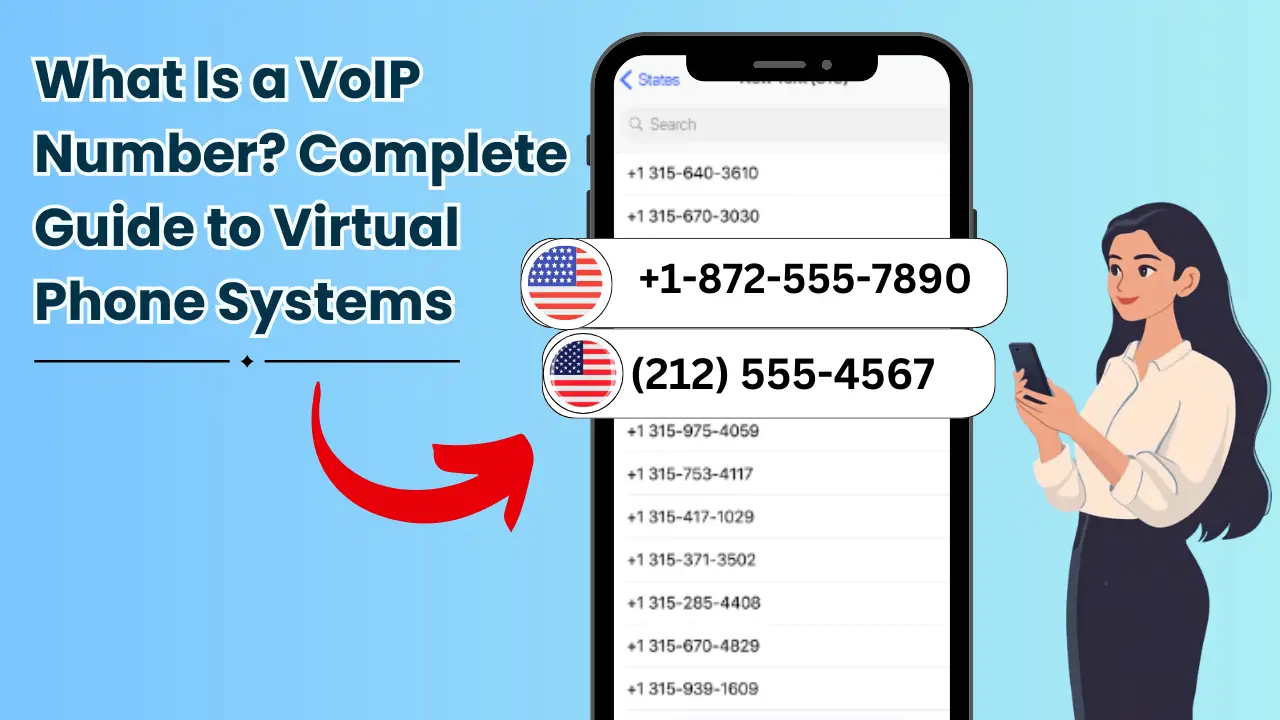Introduction
Ever thought about how businesses talk to each other all over the world without old-fashioned phone lines? The virtual phone number revolution is changing how companies talk to each other.
A VoIP number is a modern internet calling solution. It lets companies talk through digital platforms. Unlike old phones, these numbers use the Internet to call, making it cheaper and more flexible.
More and more businesses are using VoIP technology. It helps them set up professional phone lines without expensive hardware.
Key Takeaways
- VoIP numbers use the internet for voice calls
- They save a lot of money compared to old systems
- Internet calling is more mobile and grows with your business
- Remote teams can connect easily with VoIP
- Companies can talk professionally on many devices
What is a VoIP Number?
VoIP (Voice over Internet Protocol) numbers are virtual phone numbers that operate through internet connections instead of traditional phone lines, enabling calls and messaging via digital networks.
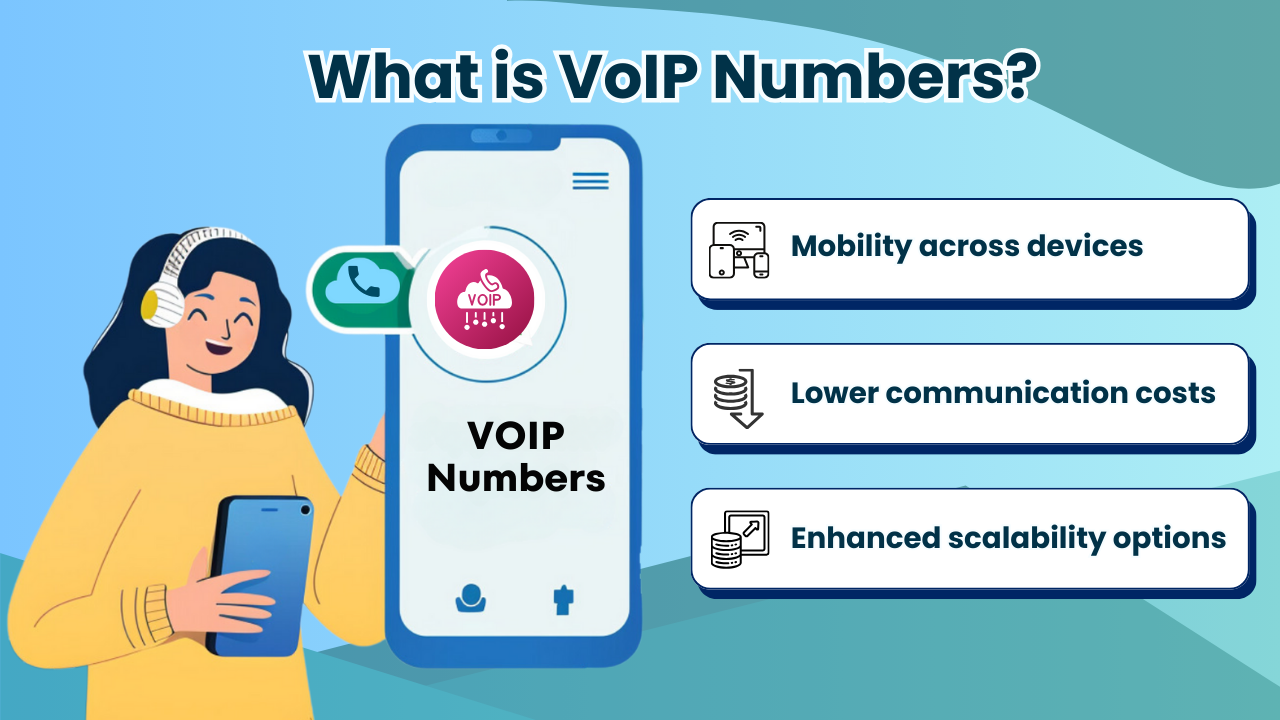
Voice over IP technology has changed how we talk online. It lets businesses and people connect in new ways. VoIP numbers work differently than old phone systems, using the internet to send voice messages.
VoIP numbers are special codes for online calls. They’re not like regular phone numbers, which are tied to one place. These virtual numbers offer flexibility and cool features for talking online.
- Digital telephone numbers can be used across multiple devices
- Internet telephony allows seamless call routing
- VoIP numbers work independently of physical location
The main benefit of VoIP is turning voice into digital data. This data moves through the internet, making talking cheaper and easier for all kinds of businesses.
VoIP numbers have some key features:
- Mobility across different devices
- Lower communication costs
- Enhanced scalability
- Advanced calling features
Using VoIP, companies can make their communication better. They can save money and make talking online more flexible. This fits well with today’s business needs.
How Do VoIP Numbers Work?
VoIP numbers change how we talk by turning voice into digital data sent over the internet. A cloud-based phone system uses this tech for flexible and efficient web calls. It helps both businesses and individuals.
The technical steps in VoIP number functionality are:
- Voice conversion from analog to digital signals
- Packet transmission through internet networks
- Routing calls via IP addresses
- Reconstructing digital signals at the destination
When you make a call through a VoIP service, your voice is turned into data packets. These packets zip across the internet fast. This lets you talk instantly, no matter where you are.
VoIP Communication Stage | Process Description |
Audio Input | Microphone captures voice signals |
Signal Conversion | Analog voice transformed to digital data |
Packet Transmission | Digital packets routed through internet |
Destination Reconstruction | Digital signals converted back to audio |
Today’s VoIP tech makes sure calls are clear and smooth. It uses top-notch codecs and strong network rules. Businesses can use these systems to improve their connections and cut down on call costs.
Benefits of VoIP Numbers for Businesses
Businesses are quickly adopting virtual phone numbers to change how they talk. An online phone number lets companies be more flexible and save money on phone costs.
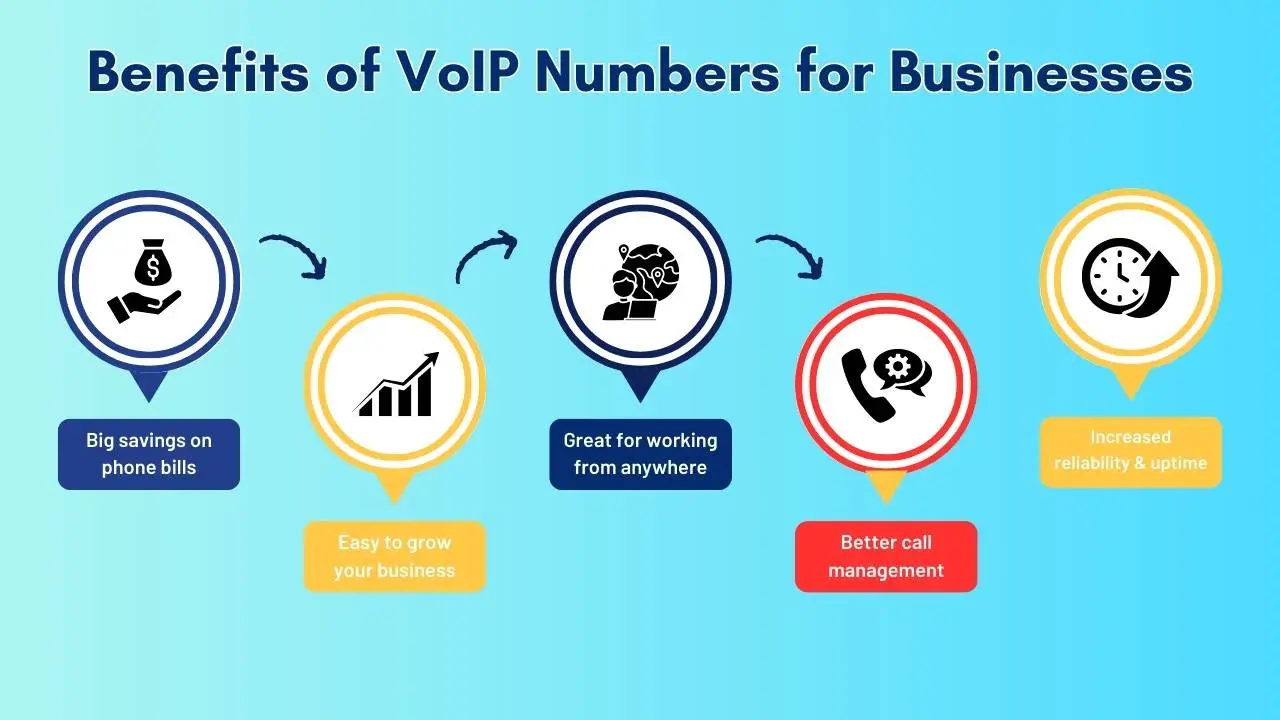
The main benefits of using internet calling for businesses include:
- Big savings on phone bills
- Easy to grow with your business
- Great for working from anywhere
- Better call management
Virtual phone systems help businesses talk more efficiently. They can set up professional networks without buying old phone equipment. This saves money.
Communication Aspect | Traditional Phone System | VoIP Phone System |
Initial Setup Cost | High | Low |
Scalability | Limited | Highly Flexible |
Geographic Restrictions | Significant | Minimal |
Companies using online phone numbers get ahead by making their communication better. They can link their calling systems with other business tools. This boosts productivity and customer service.
Today’s businesses see virtual phone numbers as more than just tech upgrades. They are key investments in communication that help businesses grow, stay flexible, and work better.
Essential Features of VoIP Systems
Today’s businesses need advanced communication tools to work better. A cloud-based phone system has key features that change how companies handle phone numbers and talk to customers.
VoIP phone numbers give businesses powerful tools. These tools help companies work better and talk to customers more effectively.
Advanced Call Management Tools
Cloud-based phone systems have advanced call tools. These tools are different from old phone systems. They include:
- Automated call routing
- Interactive voice response (IVR) menus
- Call queuing and distribution
- Voicemail-to-email transcription
- Real-time call analytics
Integration Capabilities
Digital phone systems connect well with other business software. They work smoothly with:
- Customer relationship management (CRM) platforms
- Help desk software
- Email marketing tools
- Project management applications
- Collaboration platforms
These connections help businesses work more efficiently. They make communication better and reduce manual tasks.
Setting Up Your VoIP Phone System
Setting up a VoIP service provider needs careful planning. Businesses must know the key steps for web calling success. This is important for smooth communication.
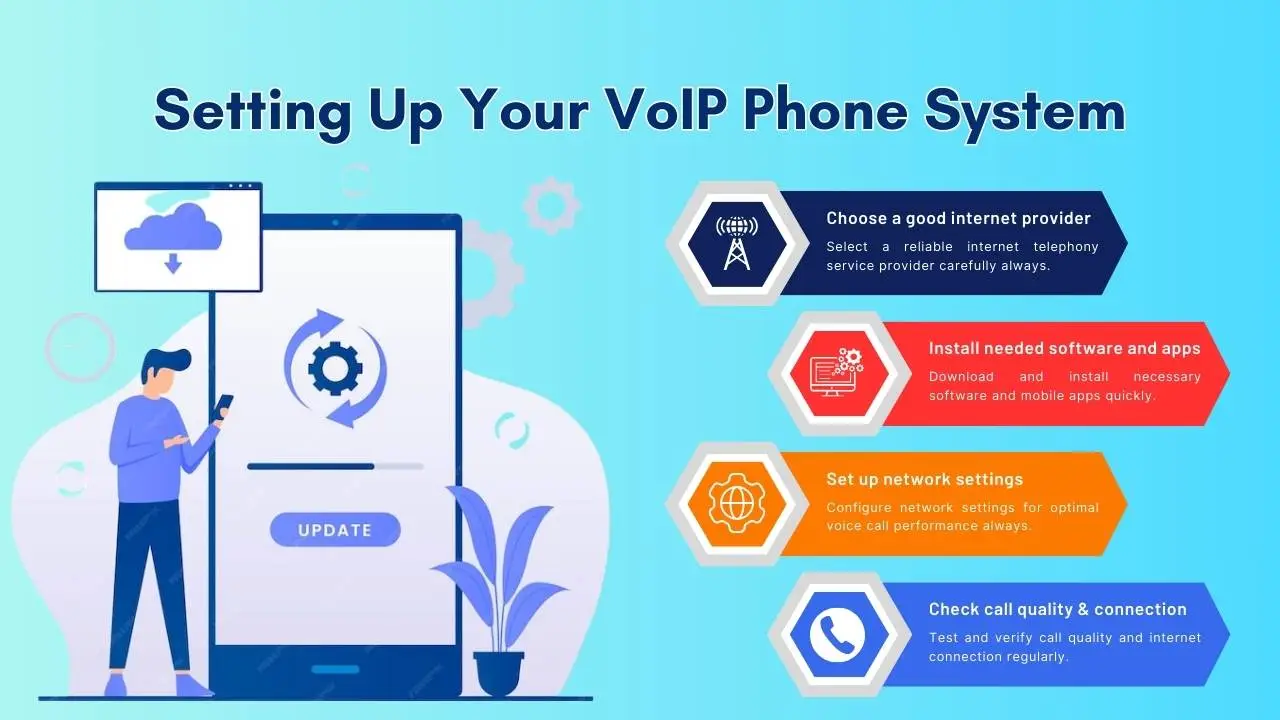
Switching to a VoIP system requires thorough preparation. You need to set up both hardware and software correctly. This ensures your business can communicate well.
Hardware Requirements
Choosing the right hardware is essential for VoIP. You’ll need:
- A fast internet router with Quality of Service (QoS)
- IP-enabled desk phones or softphone apps
- Strong ethernet connections
- Dedicated network switches for VoIP
Software Configuration Steps
Configuring your VoIP system involves several steps:
- Choose a good internet telephony provider
- Install the needed software and apps
- Set up network settings for the best performance
- Check call quality and connection
- Train staff on the new system
Businesses should focus on thorough testing and training. This ensures your new VoIP system works well. Proper setup leads to better communication in your organization.
Security Measures for VoIP Communications
Voice over IP communications have changed how businesses talk to each other. But, they also bring new security challenges. Keeping internet calling networks safe is key to protecting sensitive talks.
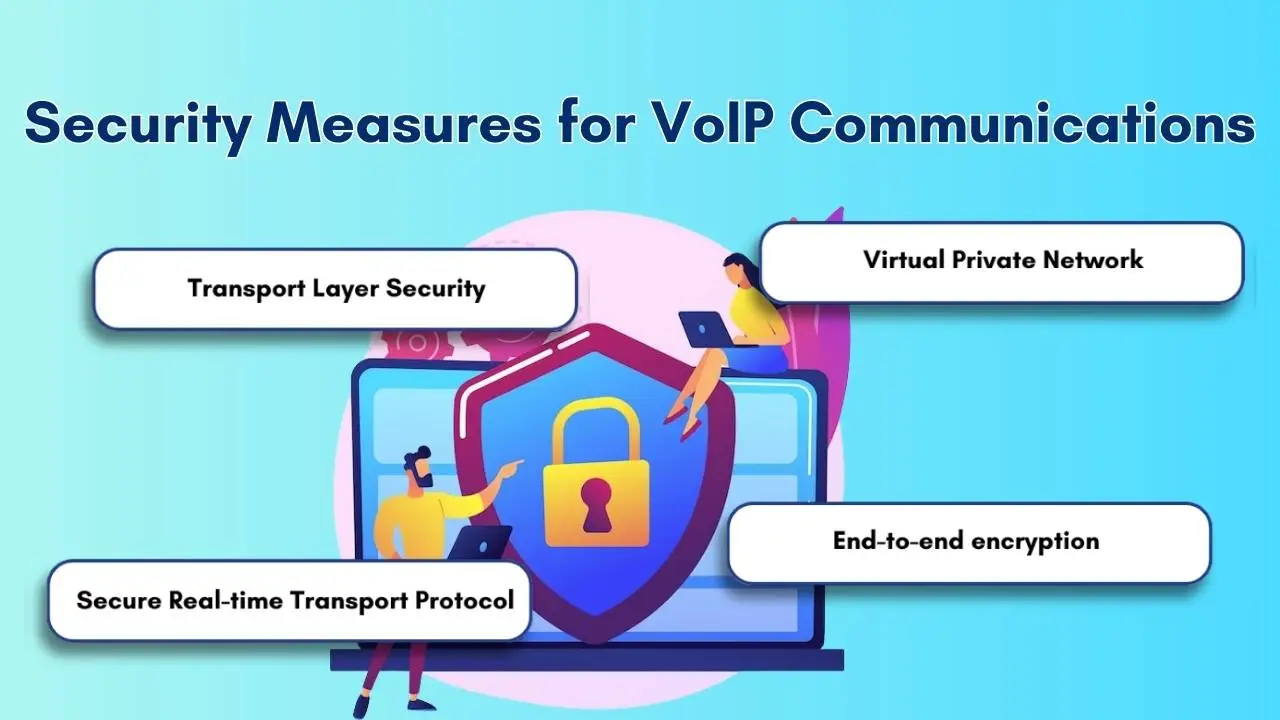
Cyber threats are always getting smarter. So, it’s vital for all businesses to protect their VoIP systems well. They need strong defense plans to stop unauthorized access and data breaches.
Encryption and Protection Methods
Good VoIP security needs many layers of protection. Important encryption methods include:
- Transport Layer Security (TLS) for signaling protection
- Secure Real-time Transport Protocol (SRTP) for media encryption
- Virtual Private Network (VPN) tunneling
- End-to-end encryption for sensitive communications
Best Practices for Secure Calling
Companies can make their voice over IP security better with these steps:
- Implement strong password policies
- Use two-factor authentication
- Regularly update software and firmware
- Configure firewalls specific to VoIP traffic
- Conduct periodic security audits
Network admins must watch for vulnerabilities in their internet calling systems. Keeping up with training and security updates can lower cyber threat risks to VoIP systems.
VoIP vs Traditional Phone Systems
Businesses today have to make big choices when picking communication tech. Virtual phone numbers have changed how companies talk. Digital phone numbers beat old landline tech in many ways.
Old phone systems use copper wires. New online phone numbers use the internet. This big difference helps businesses a lot.
Cost Comparison Analysis
Looking at costs shows big differences:
- Old phone systems cost a lot for hardware
- Virtual phone numbers save money upfront
- They also cost less every month
Cost Factor | Traditional Phone | VoIP System |
Initial Setup | $5,000 – $10,000 | $500 – $2,000 |
Monthly Maintenance | $300 – $500 | $50 – $200 |
Per-Line Expense | $50/line | $20/line |
Feature Set Differences
Online phone numbers have cool features old systems don’t:
- They offer endless call routing options
- They work all over the world
- They come with tools for talking and sharing
- They give real-time stats and reports
Companies using virtual phone numbers get ahead. They have flexible and growing ways to talk.
Business Applications of VoIP Numbers
Today, businesses are quickly moving to voip phone number technologies. They are changing how they talk to each other. Cloud-based phone systems bring flexibility and efficiency to companies looking for new ways to communicate.
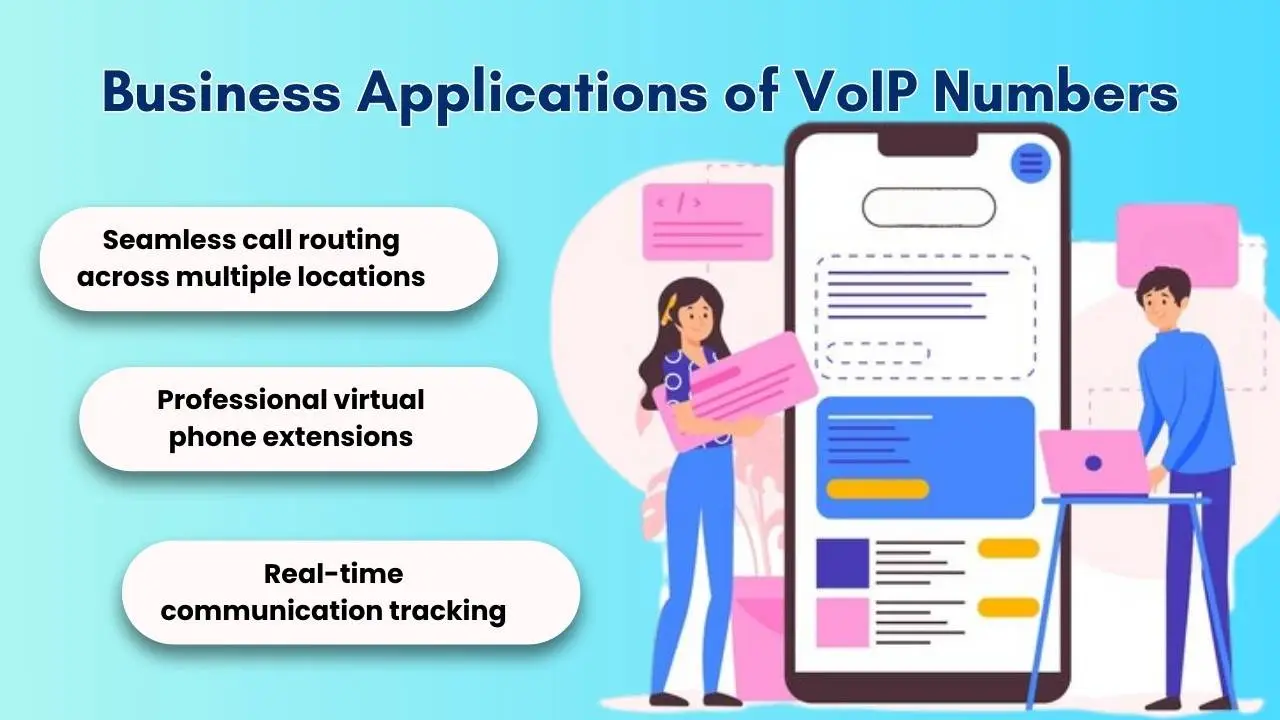
Companies use web calling to make work better and more dynamic. This change in communication helps them rethink how they work together.
Remote Work Implementation
VoIP numbers are key for teams working from anywhere. They help businesses connect remote workers easily with advanced cloud-based phone systems:
- Seamless call routing across multiple locations
- Professional virtual phone extensions
- Real-time communication tracking
- Global accessibility without physical infrastructure
Customer Service Enhancement
Customer service teams get a lot from VoIP communication. Web calling offers features that old phone systems can’t:
- Advanced call routing algorithms
- Integrated customer relationship management
- Performance analytics and monitoring
- Multi-channel communication support
By using these smart communication tools, businesses can work better and serve customers better. VoIP technologies make a big difference.
Choosing the Right VoIP Provider
Finding the right voip service provider is key for businesses wanting to use internet telephony well. The best voice over ip solution can change how you communicate, make work more efficient, and cut costs.
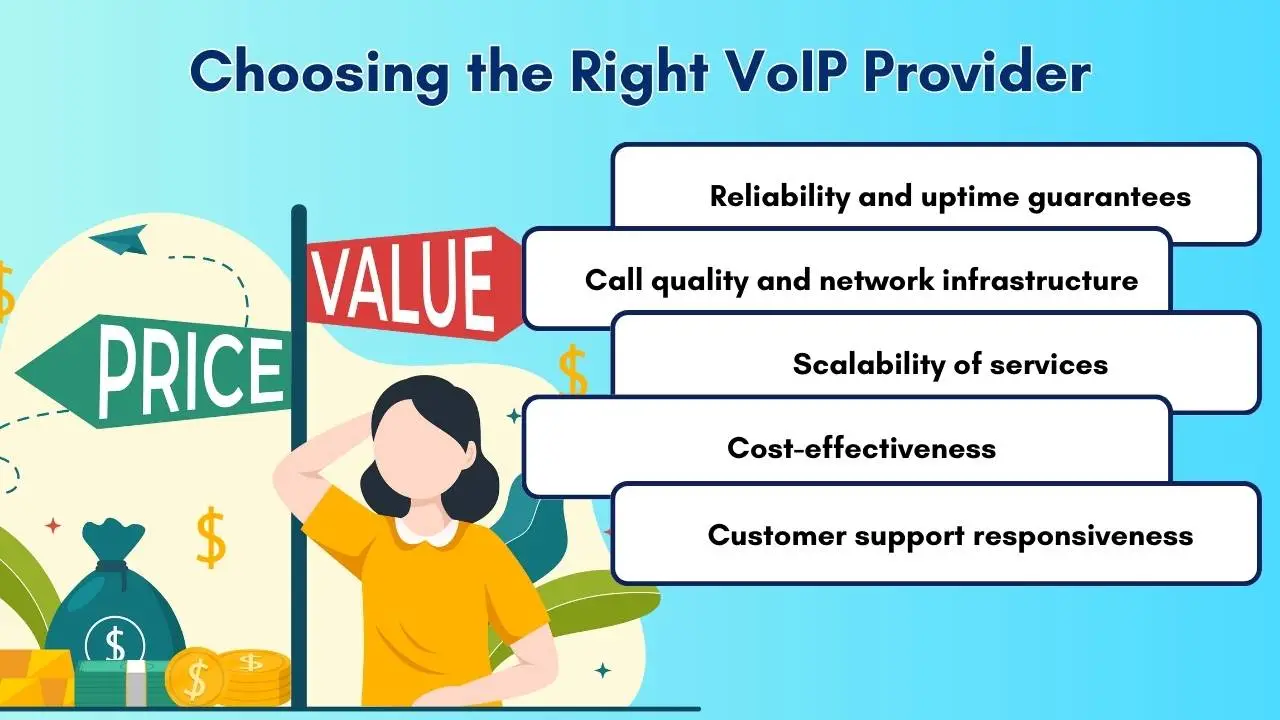
When looking at VoIP providers, businesses need to think about a few important things. This ensures the service works well and is reliable.
Key Selection Criteria
Here are the main things to look at when picking a VoIP service provider:
- Reliability and uptime guarantees
- Call quality and network infrastructure
- Scalability of services
- Cost-effectiveness
- Customer support responsiveness
Service Level Agreements
Service level agreements (SLAs) are very important. They set what a voice over ip provider promises to do. These agreements talk about how well the service will work and how support will be given.
SLA Component | Typical Expectations |
Uptime Guarantee | 99.99% network availability |
Response Time | 30 minutes for critical issues |
Technical Support | 24/7 live chat and phone support |
Maintenance Window | Minimal disruption during updates |
Businesses should look closely at these agreements. This helps them understand what service and protection they will get from their internet telephony provider.
VoIP Number Portability
Switching to a virtual phone number is key for businesses wanting better communication. Moving your current phone number to a digital system keeps things running smoothly. It also keeps your daily operations going without a hitch.
Changing your online phone number involves a few important steps. Businesses need to follow these carefully:
- Check if your current number can be ported
- Gather all needed account documents
- Ask your current provider to transfer the number
- Work with your new VoIP service provider
- Finish the transfer and start using your new number
Transfer Process Explained
When moving your digital phone number, you’ll need certain documents. These include recent bills, proof of account ownership, and permission forms from your current provider.
Getting your number ported right needs careful planning and teamwork. The time it takes can vary from 2 to 10 business days, depending on the details.
Maintaining Business Continuity
To keep your business running smoothly during the switch, follow these steps:
- Let important people know about possible service changes
- Have a backup plan for communication
- Test your new setup before you switch fully
- Keep using old ways to talk while you’re switching
Porting Consideration | Recommended Action |
Number Type | Make sure it works with your VoIP system |
Current Contract Status | Look out for early exit fees |
Technical Requirements | Check if your network is ready |
Understanding how to move your VoIP number can help your business. It lets you switch to better, cheaper ways to communicate. And it keeps your service professional and uninterrupted.
Conclusion
VoIP numbers have changed how businesses talk in the digital world. A cloud-based phone system brings flexibility, making communication better. It’s not just about saving money; it’s a smart move for today’s business.
Companies using VoIP stay ahead in communication. They can talk easily across different platforms, giving them an edge. Whether small or big, VoIP numbers help you grow and change with your business.
FAQ'S
A VoIP number is a virtual phone number that uses the internet to make calls and send messages, rather than traditional phone lines.
VoIP reduces communication costs, enhances scalability, and offers flexibility by allowing calls and messaging across multiple devices and locations.
Yes, you can port your existing phone number to a VoIP system, ensuring a smooth transition without losing your current contact number.
VoIP enables seamless communication for remote teams by providing features like call routing, virtual extensions, and real-time tracking across different locations.
VoIP systems can be secure if properly configured with encryption, firewalls, and strong authentication methods to protect against unauthorized access and data breaches.


